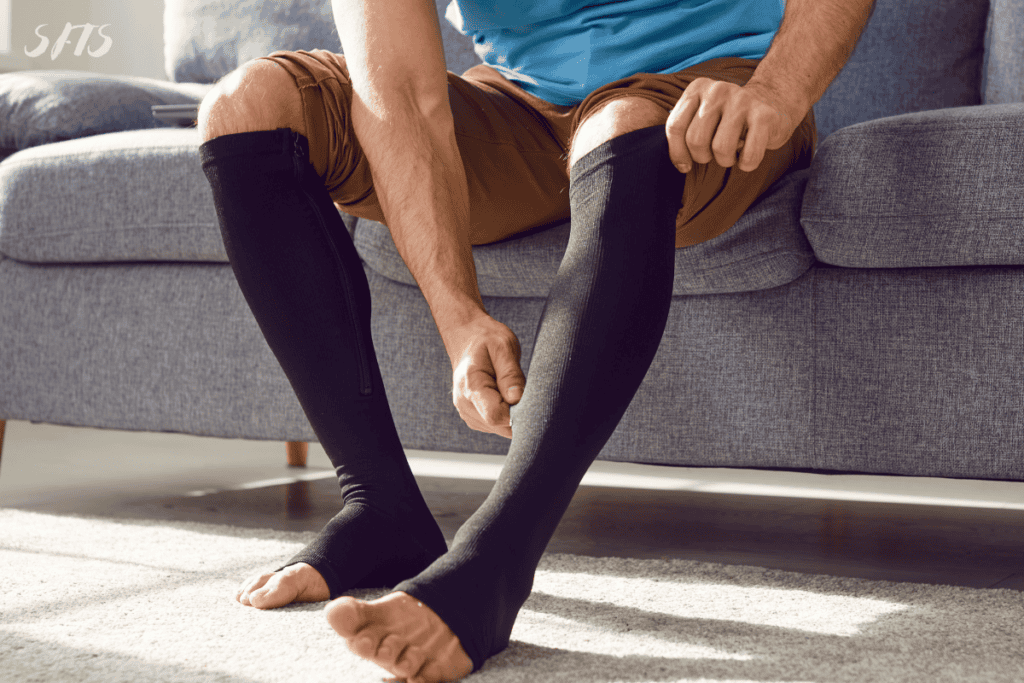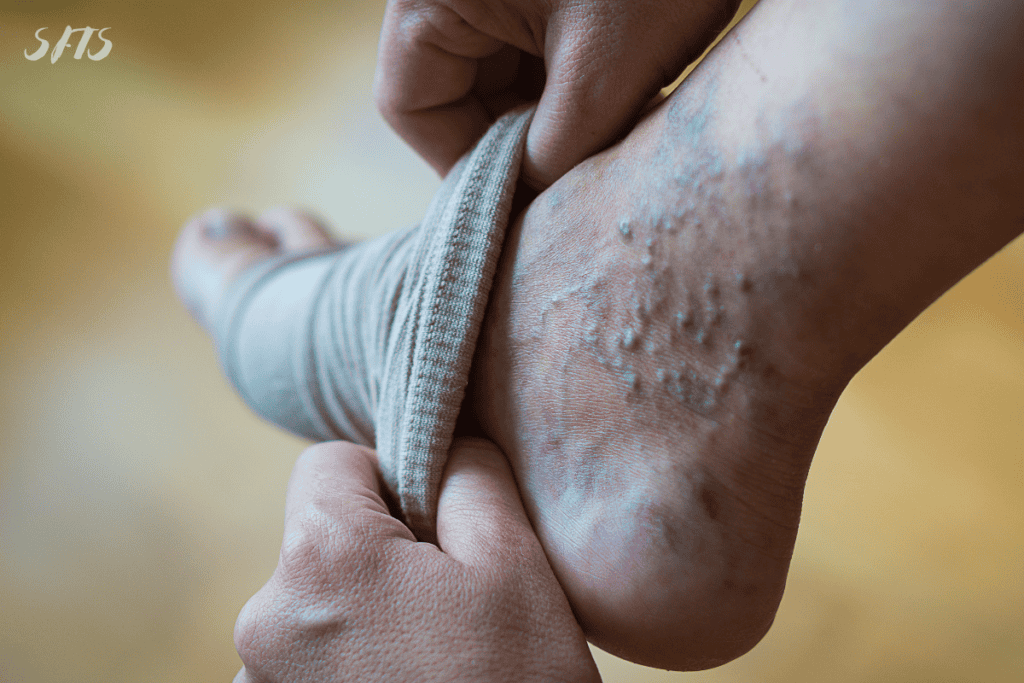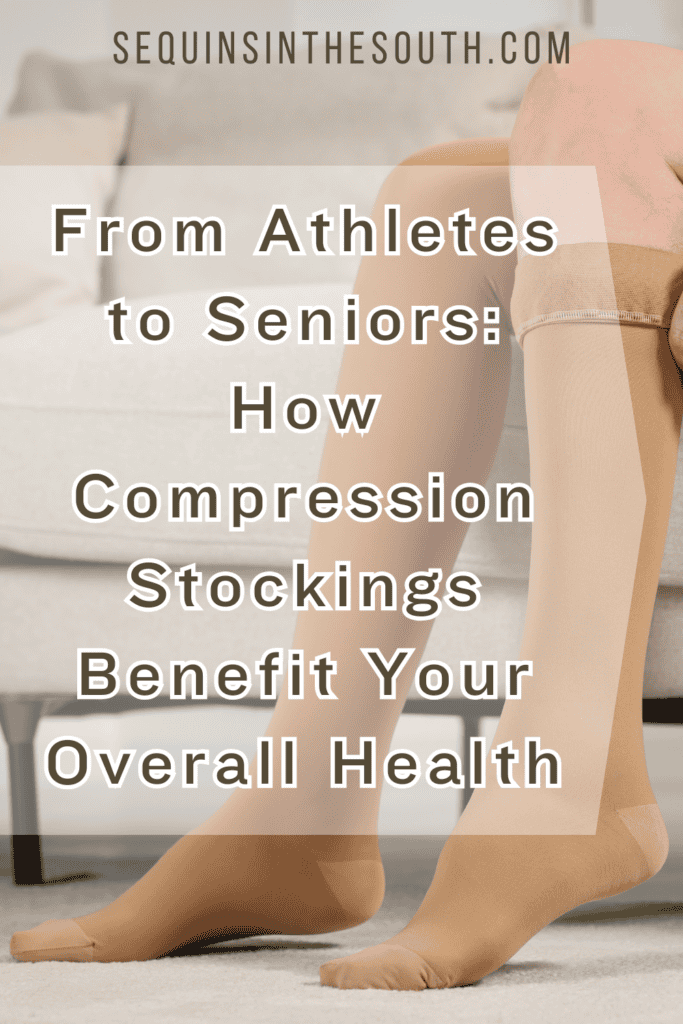Compression stockings, also known as compression socks or support stockings, are specialized garments that are designed to improve blood flow in the legs and feet. They are made from elastic materials that exert pressure on the legs, helping to squeeze the veins and muscles, and promoting better circulation.
Compression stockings have been used for centuries to treat various medical conditions and have recently gained popularity among athletes and individuals looking to improve their overall health.

The history of compression stockings dates back to ancient times. The concept of using compression to treat medical conditions can be traced back to ancient Egypt, where bandages were used to wrap the legs and provide support. In the 17th century, physicians began using compression stockings made from silk or linen to treat various conditions such as varicose veins and edema. Over the years, advancements in technology and materials have led to the development of more comfortable and effective compression stockings.
How Compression Stockings Work
Compression stockings work by applying graduated pressure on the legs, with the highest pressure at the ankle and gradually decreasing towards the top of the stocking. This graduated compression helps to improve blood flow by squeezing the veins and muscles, which in turn helps to push blood back up towards the heart. By improving circulation, compression stockings can help reduce swelling, prevent blood clots, and alleviate symptoms such as pain and fatigue.
Compression stockings come in different levels of compression, ranging from mild to extra firm. The level of compression is measured in millimeters of mercury (mmHg), with higher numbers indicating greater pressure. Mild compression stockings (8-15 mmHg) are often used for individuals who are on their feet for long periods or those who experience mild swelling or discomfort. Moderate compression stockings (15-20 mmHg) are commonly used for individuals with varicose veins or mild edema. Firm compression stockings (20-30 mmHg) are typically recommended for individuals with more severe symptoms or conditions such as deep vein thrombosis or lymphedema. Extra firm compression stockings (30-40 mmHg) are used for individuals with severe symptoms or conditions.
Benefits of Compression Stockings for Athletes
Compression stockings have gained popularity among athletes due to their potential benefits in improving performance and aiding in recovery. When worn during exercise, compression stockings can help improve blood flow and oxygen delivery to the muscles, which can enhance endurance and reduce fatigue. The compression also helps to stabilize the muscles and reduce muscle vibration, which can lead to improved muscle efficiency and reduced risk of injury.
In addition to performance benefits, compression stockings can also help athletes recover faster after intense workouts or competitions. The increased blood flow and oxygen delivery to the muscles can help remove metabolic waste products such as lactic acid, which can contribute to muscle soreness and fatigue. Compression stockings can also help reduce post-exercise swelling and inflammation, allowing athletes to recover more quickly and get back to training.
Furthermore, compression stockings can help prevent injuries such as shin splints and calf strains by providing support to the muscles and reducing muscle oscillation during exercise. The compression also helps to stabilize the joints, which can reduce the risk of sprains and strains. Overall, compression stockings can be a valuable tool for athletes looking to improve their performance, enhance recovery, and reduce the risk of injuries.
Benefits of Compression Stockings for Pregnant Women
Pregnancy can put a lot of strain on a woman’s body, particularly on the legs and feet. The weight of the growing baby, hormonal changes, and increased blood volume can lead to swelling, discomfort, and an increased risk of developing varicose veins or blood clots. Compression stockings can provide relief for pregnant women by reducing swelling and discomfort in the legs and feet.
The graduated compression of the stockings helps to improve circulation by squeezing the veins and muscles, which can prevent blood from pooling in the legs and feet. This can help reduce swelling and alleviate the discomfort associated with edema. Compression stockings can also help prevent the development of varicose veins by improving blood flow and reducing the pressure on the veins.
In addition to these benefits, compression stockings can also improve circulation for the baby. By improving blood flow in the legs, compression stockings can help ensure that oxygen and nutrients are delivered efficiently to the placenta, which is essential for the baby’s growth and development. Overall, compression stockings can be a valuable tool for pregnant women to alleviate swelling and discomfort, prevent varicose veins and blood clots, and promote better circulation for both themselves and their baby.

Benefits of Compression Stockings for People with Varicose Veins
Varicose veins are enlarged, twisted veins that usually occur in the legs and feet. They can be painful and unsightly, and if left untreated, they can lead to more serious complications such as blood clots or ulcers. Compression stockings can provide relief for individuals with varicose veins by reducing pain and swelling, preventing blood clots, and improving circulation.
The graduated compression of the stockings helps to squeeze the veins and improve blood flow, which can reduce the pressure on the varicose veins and alleviate symptoms such as pain and swelling. The compression also helps to prevent blood from pooling in the legs, which can reduce the risk of developing blood clots.
Furthermore, compression stockings can improve circulation by helping to push blood back up towards the heart. This can help prevent the development of ulcers by ensuring that oxygen and nutrients are delivered efficiently to the skin. Overall, compression stockings can be an effective non-invasive treatment option for individuals with varicose veins, providing relief from symptoms, preventing complications, and improving circulation.
Benefits of Compression Stockings for People with Lymphedema
Lymphedema is a chronic condition characterized by the accumulation of lymph fluid in the tissues, usually in the arms or legs. It can be caused by damage to the lymphatic system, such as surgery or radiation therapy for cancer. Compression stockings can be an effective treatment option for individuals with lymphedema, providing relief from swelling and discomfort, preventing infections, and improving lymphatic drainage.
The graduated compression of the stockings helps to reduce swelling by squeezing the tissues and improving lymphatic flow. This can help alleviate the discomfort associated with lymphedema and prevent the development of infections. Compression stockings can also help improve lymphatic drainage by providing external pressure on the tissues, which can help move the lymph fluid more efficiently.
Furthermore, compression stockings can help prevent the progression of lymphedema by reducing the risk of complications such as cellulitis or lymphangitis. By improving circulation and reducing swelling, compression stockings can help maintain the health of the tissues and prevent further damage to the lymphatic system. Overall, compression stockings can be a valuable tool for individuals with lymphedema, providing relief from symptoms, preventing complications, and improving lymphatic drainage.
Benefits of Compression Stockings for People with Diabetes
Diabetes is a chronic condition characterized by high blood sugar levels. It can lead to various complications, including poor circulation, slow wound healing, and an increased risk of infections. Compression stockings can be beneficial for individuals with diabetes by improving circulation and wound healing, preventing ulcers and infections, and reducing the risk of amputation.
Poor circulation is a common problem in individuals with diabetes, which can lead to complications such as foot ulcers or infections. Compression stockings can help improve circulation by squeezing the veins and muscles, which can promote better blood flow to the extremities. This can help prevent the development of ulcers by ensuring that oxygen and nutrients are delivered efficiently to the skin.
Furthermore, compression stockings can help promote wound healing by providing external pressure on the tissues, which can help reduce swelling and inflammation. This can help speed up the healing process and reduce the risk of infections.
Compression stockings can also help reduce the risk of amputation by improving circulation and preventing the development of ulcers or infections.
Overall, compression stockings can be a valuable tool for individuals with diabetes, promoting better circulation and wound healing and reducing the risk of complications.

Benefits of Compression Stockings for People with Deep Vein Thrombosis
Deep vein thrombosis (DVT) is a condition characterized by the formation of blood clots in the deep veins, usually in the legs. It can be a serious condition that can lead to complications such as pulmonary embolism, which is a potentially life-threatening condition. Compression stockings can be an effective treatment option for individuals with DVT, preventing blood clots, reducing the risk of pulmonary embolism, and improving circulation.
The graduated compression of the stockings helps to improve blood flow by squeezing the veins and muscles, which can prevent blood from pooling in the legs and reduce the risk of developing blood clots. Compression stockings can also help prevent the progression of DVT by providing external pressure on the veins, which can help keep the blood flowing and prevent further clot formation.
Furthermore, compression stockings can help reduce the risk of pulmonary embolism by improving circulation and preventing clot migration to the lungs. By improving blood flow and reducing the risk of clot formation, compression stockings can help ensure that oxygen and nutrients are delivered efficiently to the tissues and prevent complications. Overall, compression stockings can be a valuable tool for individuals with DVT, preventing blood clots, reducing the risk of pulmonary embolism, and improving circulation.
Benefits of Compression Stockings for People with Arthritis
Arthritis is a chronic condition characterized by inflammation and pain in the joints. It can be a debilitating condition that can affect mobility and quality of life. Compression stockings can provide relief for individuals with arthritis by reducing pain and swelling, improving joint mobility, and preventing blood clots.
The graduated compression of the stockings helps to reduce pain and swelling by squeezing the tissues and improving circulation. This can help alleviate the discomfort associated with arthritis and promote better joint health. Compression stockings can also help improve joint mobility by providing support to the muscles and reducing inflammation. This can help individuals with arthritis maintain their independence and engage in activities that they enjoy.
Furthermore, compression stockings can help prevent the development of blood clots, which can be a complication of arthritis. By improving circulation and reducing the risk of clot formation, compression stockings can help ensure that oxygen and nutrients are delivered efficiently to the tissues and prevent complications. Overall, compression stockings can be a valuable tool for individuals with arthritis, providing relief from symptoms, improving joint mobility, and preventing complications.
Benefits of Compression Stockings for Seniors
As we age, our bodies undergo various changes that can affect our overall health and well-being. Poor circulation, decreased mobility, and an increased risk of falls are common problems among seniors. Compression stockings can be beneficial for seniors by reducing the risk of falls and injuries, improving circulation and mobility, and preventing blood clots and ulcers.
Compression stockings can help reduce the risk of falls and injuries by providing support to the muscles and improving balance. The compression also helps to stabilize the joints, which can reduce the risk of sprains or fractures. By improving circulation, compression stockings can also help prevent dizziness or lightheadedness, which can contribute to falls.
Furthermore, compression stockings can improve circulation by squeezing the veins and muscles, which can promote better blood flow to the extremities. This can help reduce swelling and alleviate symptoms such as pain or fatigue. Compression stockings can also help prevent the development of blood clots or ulcers by ensuring that oxygen and nutrients are delivered efficiently to the tissues. Overall, compression stockings can be a valuable tool for seniors, promoting better circulation, mobility, and reducing the risk of falls and complications.
The Importance of Compression Stockings for Your Overall Health
Compression stockings have been used for centuries to treat various medical conditions and have recently gained popularity among athletes and individuals looking to improve their overall health.
They work by applying graduated pressure on the legs, improving circulation, reducing swelling, and alleviating symptoms such as pain and fatigue. Compression stockings come in different levels of compression, ranging from mild to extra firm, depending on the severity of the condition.
Compression stockings offer numerous benefits for different populations. For athletes, they can improve performance, reduce muscle soreness and fatigue, and prevent injuries. Pregnant women can benefit from reduced swelling and discomfort, prevention of varicose veins and blood clots, and improved circulation for the baby.
Individuals with varicose veins can experience reduced pain and swelling, prevention of blood clots, and improved circulation. Those with lymphedema can benefit from reduced swelling and discomfort, prevention of infections, and improved lymphatic drainage.
People with diabetes can experience improved circulation and wound healing, prevention of ulcers and infections, and a reduced risk of amputation. Compression stockings can also be beneficial for individuals with deep vein thrombosis by preventing blood clots, reducing the risk of pulmonary embolism, and improving circulation.
Those with arthritis can experience reduced pain and swelling, improved joint mobility, and prevention of blood clots. Seniors can benefit from a reduced risk of falls and injuries, improved circulation and mobility, and prevention of blood clots and ulcers.

It is important to consult with a healthcare professional before using compression stockings to ensure proper fit and appropriate level of compression. They can provide guidance on the best type of compression stockings for your specific needs.
Compression stockings are a valuable tool for improving overall health and well-being, and they are worth considering for anyone looking to enhance their circulation, reduce swelling, and prevent complications. Give compression stockings a try and experience the benefits for yourself.
Leave a Reply